Digital Marketing: Transformation in Business and Consumer Behavior
VerifiedAdded on 2021/08/03
|29
|6378
|77
Report
AI Summary
This report provides a comprehensive introduction to digital marketing, emphasizing its significance in today's business environment. It defines digital marketing, highlighting its use of digital channels like websites, social media, and search engines to connect with consumers. The report discusses the shift from traditional marketing, presenting statistics on internet users and online sales to demonstrate the growth of digital marketing. It explains key concepts such as the RACE framework (Reach, Act, Convert, Engage) and various digital marketing disciplines including content, SEO, social media, and email marketing. The report further explores the reasons behind the importance of digital marketing, including efficient customer reach, marketing intelligence, and cost-effectiveness, particularly for small and medium-sized businesses. It also provides comparisons between traditional and digital marketing spend, and emphasizes the importance of online presence and competitor analysis. The report references multiple research papers and studies to support its claims and provide further reading materials for the reader.
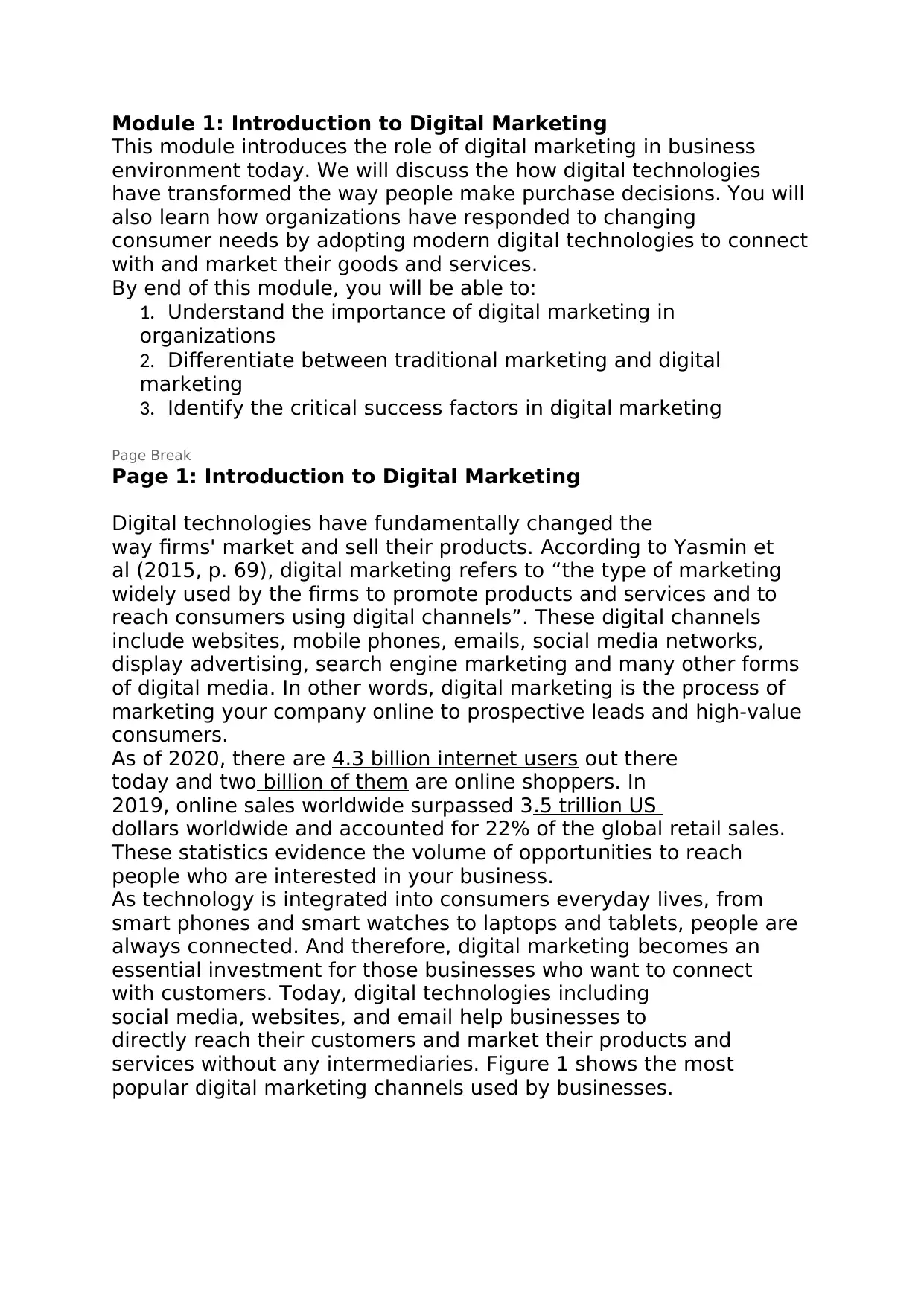
Module 1: Introduction to Digital Marketing
This module introduces the role of digital marketing in business
environment today. We will discuss the how digital technologies
have transformed the way people make purchase decisions. You will
also learn how organizations have responded to changing
consumer needs by adopting modern digital technologies to connect
with and market their goods and services.
By end of this module, you will be able to:
1. Understand the importance of digital marketing in
organizations
2. Differentiate between traditional marketing and digital
marketing
3. Identify the critical success factors in digital marketing
Page Break
Page 1: Introduction to Digital Marketing
Digital technologies have fundamentally changed the
way firms' market and sell their products. According to Yasmin et
al (2015, p. 69), digital marketing refers to “the type of marketing
widely used by the firms to promote products and services and to
reach consumers using digital channels”. These digital channels
include websites, mobile phones, emails, social media networks,
display advertising, search engine marketing and many other forms
of digital media. In other words, digital marketing is the process of
marketing your company online to prospective leads and high-value
consumers.
As of 2020, there are 4.3 billion internet users out there
today and two billion of them are online shoppers. In
2019, online sales worldwide surpassed 3.5 trillion US
dollars worldwide and accounted for 22% of the global retail sales.
These statistics evidence the volume of opportunities to reach
people who are interested in your business.
As technology is integrated into consumers everyday lives, from
smart phones and smart watches to laptops and tablets, people are
always connected. And therefore, digital marketing becomes an
essential investment for those businesses who want to connect
with customers. Today, digital technologies including
social media, websites, and email help businesses to
directly reach their customers and market their products and
services without any intermediaries. Figure 1 shows the most
popular digital marketing channels used by businesses.
This module introduces the role of digital marketing in business
environment today. We will discuss the how digital technologies
have transformed the way people make purchase decisions. You will
also learn how organizations have responded to changing
consumer needs by adopting modern digital technologies to connect
with and market their goods and services.
By end of this module, you will be able to:
1. Understand the importance of digital marketing in
organizations
2. Differentiate between traditional marketing and digital
marketing
3. Identify the critical success factors in digital marketing
Page Break
Page 1: Introduction to Digital Marketing
Digital technologies have fundamentally changed the
way firms' market and sell their products. According to Yasmin et
al (2015, p. 69), digital marketing refers to “the type of marketing
widely used by the firms to promote products and services and to
reach consumers using digital channels”. These digital channels
include websites, mobile phones, emails, social media networks,
display advertising, search engine marketing and many other forms
of digital media. In other words, digital marketing is the process of
marketing your company online to prospective leads and high-value
consumers.
As of 2020, there are 4.3 billion internet users out there
today and two billion of them are online shoppers. In
2019, online sales worldwide surpassed 3.5 trillion US
dollars worldwide and accounted for 22% of the global retail sales.
These statistics evidence the volume of opportunities to reach
people who are interested in your business.
As technology is integrated into consumers everyday lives, from
smart phones and smart watches to laptops and tablets, people are
always connected. And therefore, digital marketing becomes an
essential investment for those businesses who want to connect
with customers. Today, digital technologies including
social media, websites, and email help businesses to
directly reach their customers and market their products and
services without any intermediaries. Figure 1 shows the most
popular digital marketing channels used by businesses.
Paraphrase This Document
Need a fresh take? Get an instant paraphrase of this document with our AI Paraphraser
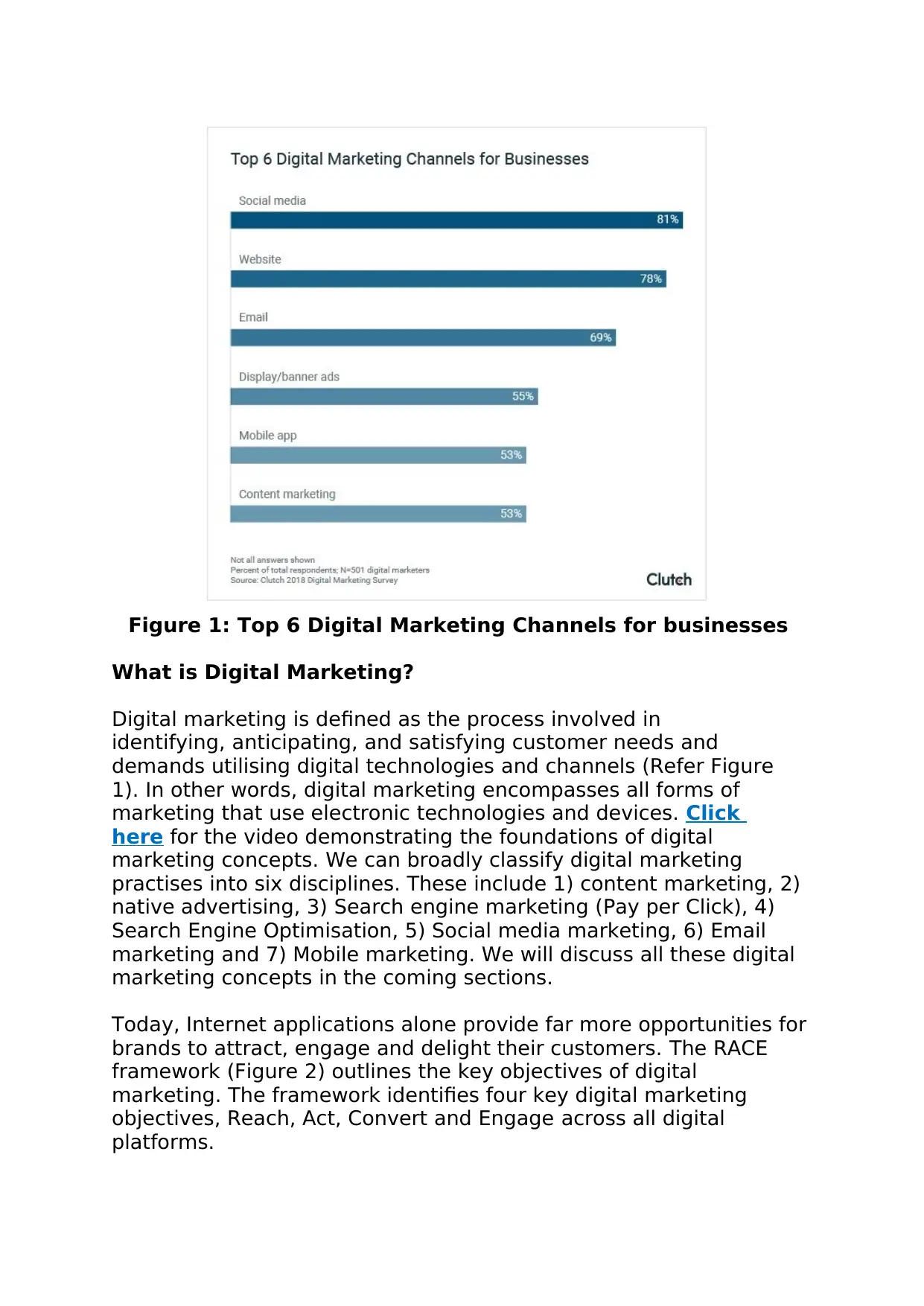
Figure 1: Top 6 Digital Marketing Channels for businesses
What is Digital Marketing?
Digital marketing is defined as the process involved in
identifying, anticipating, and satisfying customer needs and
demands utilising digital technologies and channels (Refer Figure
1). In other words, digital marketing encompasses all forms of
marketing that use electronic technologies and devices. Click
here for the video demonstrating the foundations of digital
marketing concepts. We can broadly classify digital marketing
practises into six disciplines. These include 1) content marketing, 2)
native advertising, 3) Search engine marketing (Pay per Click), 4)
Search Engine Optimisation, 5) Social media marketing, 6) Email
marketing and 7) Mobile marketing. We will discuss all these digital
marketing concepts in the coming sections.
Today, Internet applications alone provide far more opportunities for
brands to attract, engage and delight their customers. The RACE
framework (Figure 2) outlines the key objectives of digital
marketing. The framework identifies four key digital marketing
objectives, Reach, Act, Convert and Engage across all digital
platforms.
What is Digital Marketing?
Digital marketing is defined as the process involved in
identifying, anticipating, and satisfying customer needs and
demands utilising digital technologies and channels (Refer Figure
1). In other words, digital marketing encompasses all forms of
marketing that use electronic technologies and devices. Click
here for the video demonstrating the foundations of digital
marketing concepts. We can broadly classify digital marketing
practises into six disciplines. These include 1) content marketing, 2)
native advertising, 3) Search engine marketing (Pay per Click), 4)
Search Engine Optimisation, 5) Social media marketing, 6) Email
marketing and 7) Mobile marketing. We will discuss all these digital
marketing concepts in the coming sections.
Today, Internet applications alone provide far more opportunities for
brands to attract, engage and delight their customers. The RACE
framework (Figure 2) outlines the key objectives of digital
marketing. The framework identifies four key digital marketing
objectives, Reach, Act, Convert and Engage across all digital
platforms.
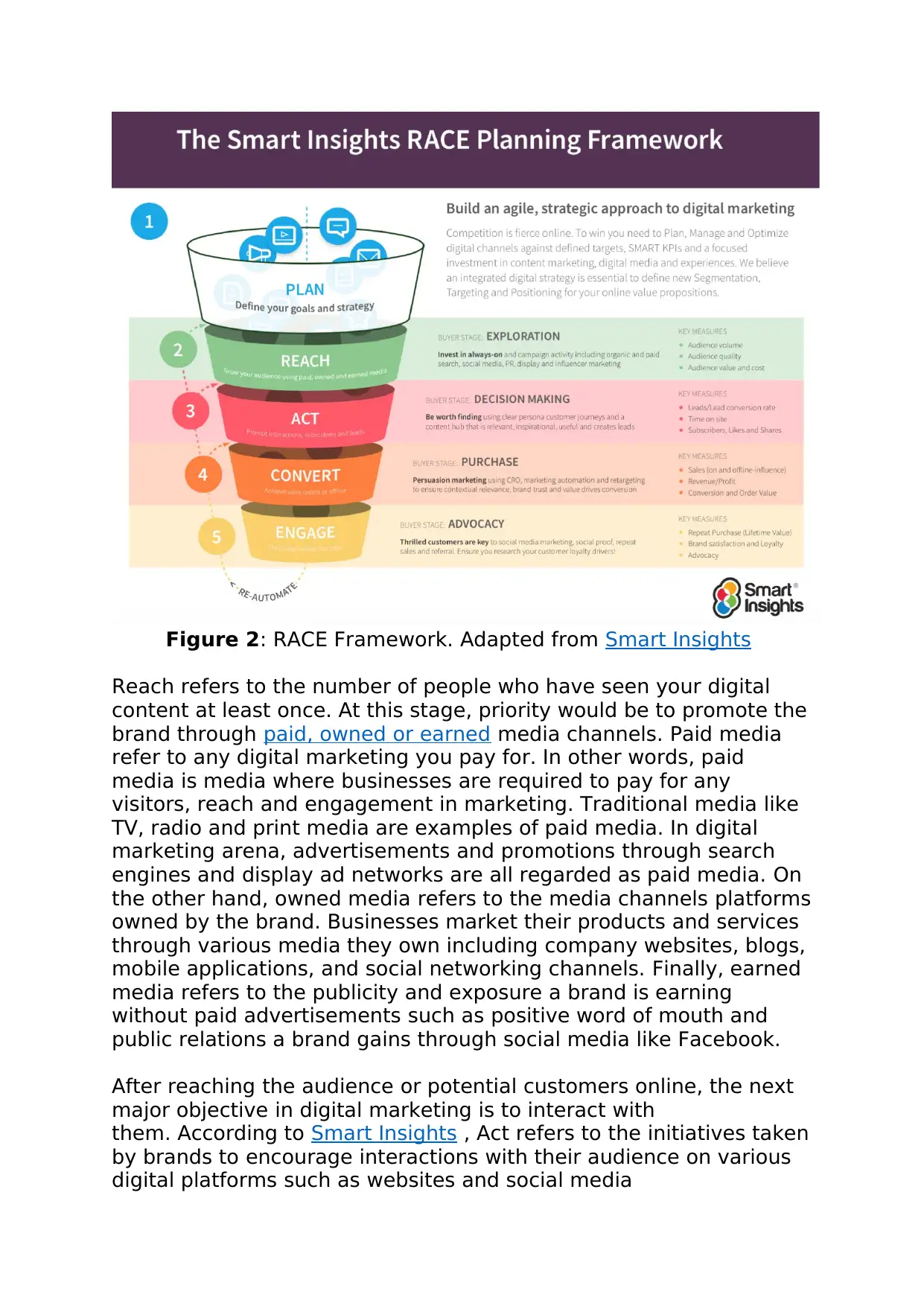
Figure 2: RACE Framework. Adapted from Smart Insights
Reach refers to the number of people who have seen your digital
content at least once. At this stage, priority would be to promote the
brand through paid, owned or earned media channels. Paid media
refer to any digital marketing you pay for. In other words, paid
media is media where businesses are required to pay for any
visitors, reach and engagement in marketing. Traditional media like
TV, radio and print media are examples of paid media. In digital
marketing arena, advertisements and promotions through search
engines and display ad networks are all regarded as paid media. On
the other hand, owned media refers to the media channels platforms
owned by the brand. Businesses market their products and services
through various media they own including company websites, blogs,
mobile applications, and social networking channels. Finally, earned
media refers to the publicity and exposure a brand is earning
without paid advertisements such as positive word of mouth and
public relations a brand gains through social media like Facebook.
After reaching the audience or potential customers online, the next
major objective in digital marketing is to interact with
them. According to Smart Insights , Act refers to the initiatives taken
by brands to encourage interactions with their audience on various
digital platforms such as websites and social media
Reach refers to the number of people who have seen your digital
content at least once. At this stage, priority would be to promote the
brand through paid, owned or earned media channels. Paid media
refer to any digital marketing you pay for. In other words, paid
media is media where businesses are required to pay for any
visitors, reach and engagement in marketing. Traditional media like
TV, radio and print media are examples of paid media. In digital
marketing arena, advertisements and promotions through search
engines and display ad networks are all regarded as paid media. On
the other hand, owned media refers to the media channels platforms
owned by the brand. Businesses market their products and services
through various media they own including company websites, blogs,
mobile applications, and social networking channels. Finally, earned
media refers to the publicity and exposure a brand is earning
without paid advertisements such as positive word of mouth and
public relations a brand gains through social media like Facebook.
After reaching the audience or potential customers online, the next
major objective in digital marketing is to interact with
them. According to Smart Insights , Act refers to the initiatives taken
by brands to encourage interactions with their audience on various
digital platforms such as websites and social media
⊘ This is a preview!⊘
Do you want full access?
Subscribe today to unlock all pages.

Trusted by 1+ million students worldwide
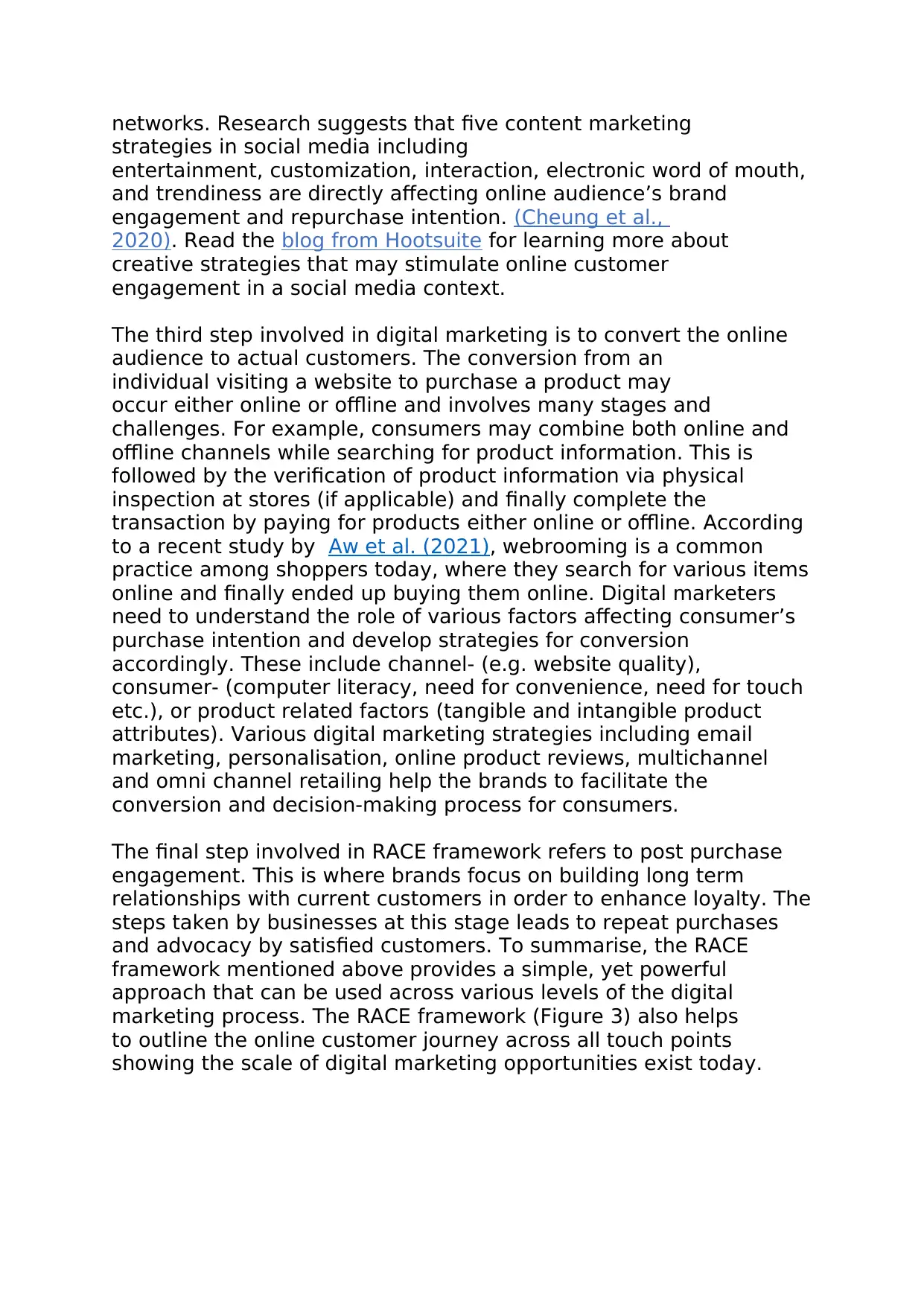
networks. Research suggests that five content marketing
strategies in social media including
entertainment, customization, interaction, electronic word of mouth,
and trendiness are directly affecting online audience’s brand
engagement and repurchase intention. (Cheung et al.,
2020). Read the blog from Hootsuite for learning more about
creative strategies that may stimulate online customer
engagement in a social media context.
The third step involved in digital marketing is to convert the online
audience to actual customers. The conversion from an
individual visiting a website to purchase a product may
occur either online or offline and involves many stages and
challenges. For example, consumers may combine both online and
offline channels while searching for product information. This is
followed by the verification of product information via physical
inspection at stores (if applicable) and finally complete the
transaction by paying for products either online or offline. According
to a recent study by Aw et al. (2021), webrooming is a common
practice among shoppers today, where they search for various items
online and finally ended up buying them online. Digital marketers
need to understand the role of various factors affecting consumer’s
purchase intention and develop strategies for conversion
accordingly. These include channel- (e.g. website quality),
consumer- (computer literacy, need for convenience, need for touch
etc.), or product related factors (tangible and intangible product
attributes). Various digital marketing strategies including email
marketing, personalisation, online product reviews, multichannel
and omni channel retailing help the brands to facilitate the
conversion and decision-making process for consumers.
The final step involved in RACE framework refers to post purchase
engagement. This is where brands focus on building long term
relationships with current customers in order to enhance loyalty. The
steps taken by businesses at this stage leads to repeat purchases
and advocacy by satisfied customers. To summarise, the RACE
framework mentioned above provides a simple, yet powerful
approach that can be used across various levels of the digital
marketing process. The RACE framework (Figure 3) also helps
to outline the online customer journey across all touch points
showing the scale of digital marketing opportunities exist today.
strategies in social media including
entertainment, customization, interaction, electronic word of mouth,
and trendiness are directly affecting online audience’s brand
engagement and repurchase intention. (Cheung et al.,
2020). Read the blog from Hootsuite for learning more about
creative strategies that may stimulate online customer
engagement in a social media context.
The third step involved in digital marketing is to convert the online
audience to actual customers. The conversion from an
individual visiting a website to purchase a product may
occur either online or offline and involves many stages and
challenges. For example, consumers may combine both online and
offline channels while searching for product information. This is
followed by the verification of product information via physical
inspection at stores (if applicable) and finally complete the
transaction by paying for products either online or offline. According
to a recent study by Aw et al. (2021), webrooming is a common
practice among shoppers today, where they search for various items
online and finally ended up buying them online. Digital marketers
need to understand the role of various factors affecting consumer’s
purchase intention and develop strategies for conversion
accordingly. These include channel- (e.g. website quality),
consumer- (computer literacy, need for convenience, need for touch
etc.), or product related factors (tangible and intangible product
attributes). Various digital marketing strategies including email
marketing, personalisation, online product reviews, multichannel
and omni channel retailing help the brands to facilitate the
conversion and decision-making process for consumers.
The final step involved in RACE framework refers to post purchase
engagement. This is where brands focus on building long term
relationships with current customers in order to enhance loyalty. The
steps taken by businesses at this stage leads to repeat purchases
and advocacy by satisfied customers. To summarise, the RACE
framework mentioned above provides a simple, yet powerful
approach that can be used across various levels of the digital
marketing process. The RACE framework (Figure 3) also helps
to outline the online customer journey across all touch points
showing the scale of digital marketing opportunities exist today.
Paraphrase This Document
Need a fresh take? Get an instant paraphrase of this document with our AI Paraphraser
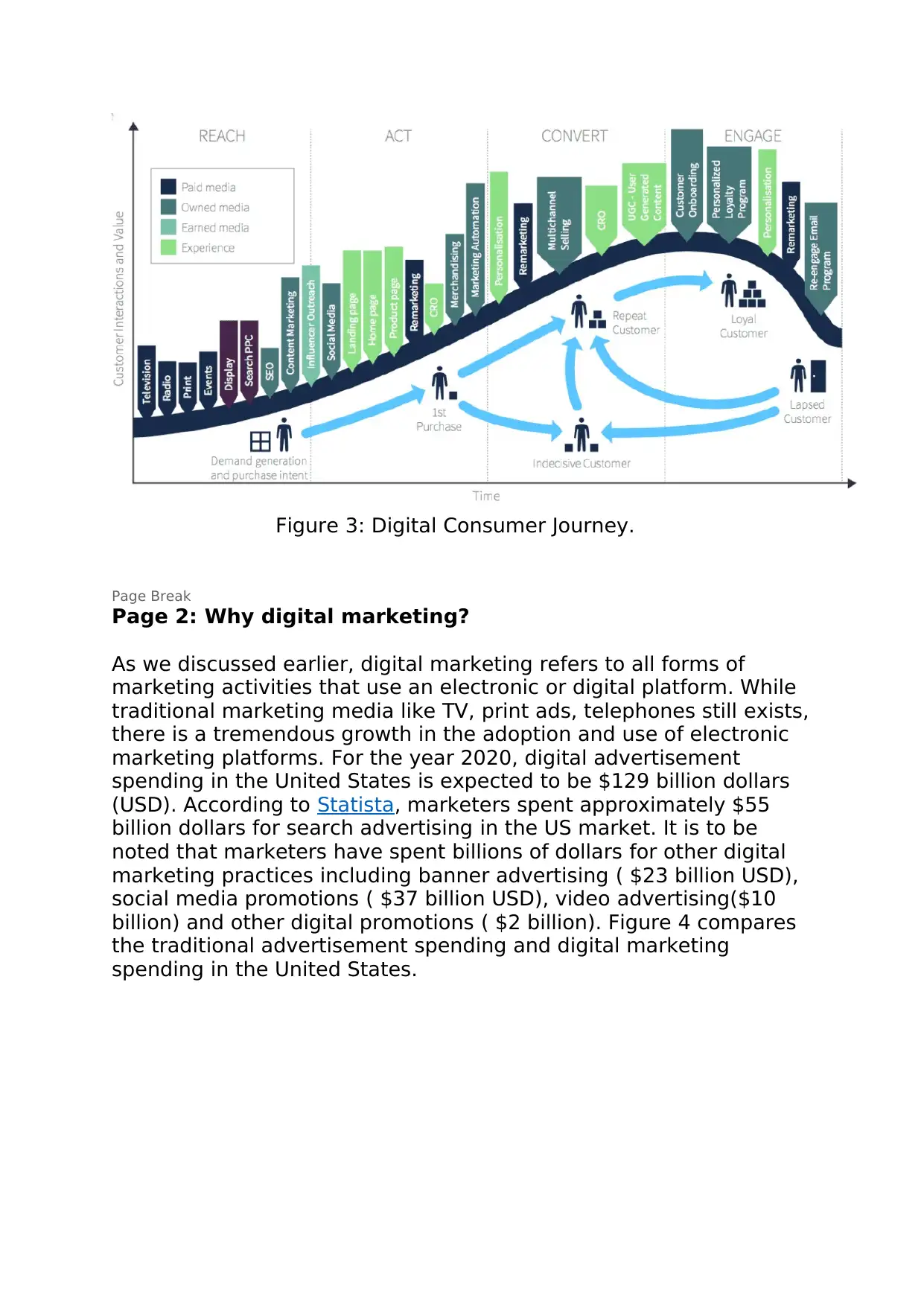
Figure 3: Digital Consumer Journey.
Page Break
Page 2: Why digital marketing?
As we discussed earlier, digital marketing refers to all forms of
marketing activities that use an electronic or digital platform. While
traditional marketing media like TV, print ads, telephones still exists,
there is a tremendous growth in the adoption and use of electronic
marketing platforms. For the year 2020, digital advertisement
spending in the United States is expected to be $129 billion dollars
(USD). According to Statista, marketers spent approximately $55
billion dollars for search advertising in the US market. It is to be
noted that marketers have spent billions of dollars for other digital
marketing practices including banner advertising ( $23 billion USD),
social media promotions ( $37 billion USD), video advertising($10
billion) and other digital promotions ( $2 billion). Figure 4 compares
the traditional advertisement spending and digital marketing
spending in the United States.
Page Break
Page 2: Why digital marketing?
As we discussed earlier, digital marketing refers to all forms of
marketing activities that use an electronic or digital platform. While
traditional marketing media like TV, print ads, telephones still exists,
there is a tremendous growth in the adoption and use of electronic
marketing platforms. For the year 2020, digital advertisement
spending in the United States is expected to be $129 billion dollars
(USD). According to Statista, marketers spent approximately $55
billion dollars for search advertising in the US market. It is to be
noted that marketers have spent billions of dollars for other digital
marketing practices including banner advertising ( $23 billion USD),
social media promotions ( $37 billion USD), video advertising($10
billion) and other digital promotions ( $2 billion). Figure 4 compares
the traditional advertisement spending and digital marketing
spending in the United States.
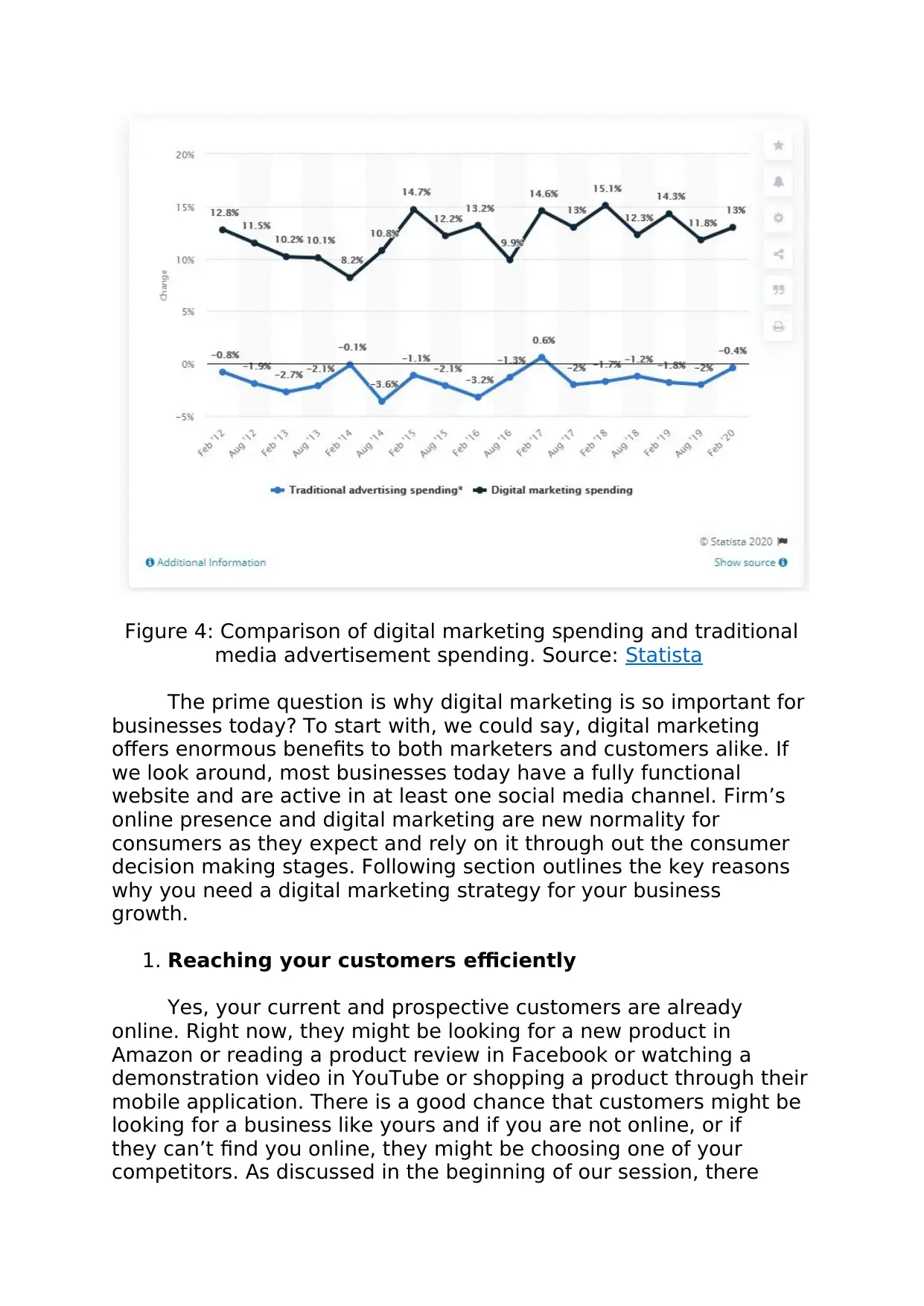
Figure 4: Comparison of digital marketing spending and traditional
media advertisement spending. Source: Statista
The prime question is why digital marketing is so important for
businesses today? To start with, we could say, digital marketing
offers enormous benefits to both marketers and customers alike. If
we look around, most businesses today have a fully functional
website and are active in at least one social media channel. Firm’s
online presence and digital marketing are new normality for
consumers as they expect and rely on it through out the consumer
decision making stages. Following section outlines the key reasons
why you need a digital marketing strategy for your business
growth.
1. Reaching your customers efficiently
Yes, your current and prospective customers are already
online. Right now, they might be looking for a new product in
Amazon or reading a product review in Facebook or watching a
demonstration video in YouTube or shopping a product through their
mobile application. There is a good chance that customers might be
looking for a business like yours and if you are not online, or if
they can’t find you online, they might be choosing one of your
competitors. As discussed in the beginning of our session, there
media advertisement spending. Source: Statista
The prime question is why digital marketing is so important for
businesses today? To start with, we could say, digital marketing
offers enormous benefits to both marketers and customers alike. If
we look around, most businesses today have a fully functional
website and are active in at least one social media channel. Firm’s
online presence and digital marketing are new normality for
consumers as they expect and rely on it through out the consumer
decision making stages. Following section outlines the key reasons
why you need a digital marketing strategy for your business
growth.
1. Reaching your customers efficiently
Yes, your current and prospective customers are already
online. Right now, they might be looking for a new product in
Amazon or reading a product review in Facebook or watching a
demonstration video in YouTube or shopping a product through their
mobile application. There is a good chance that customers might be
looking for a business like yours and if you are not online, or if
they can’t find you online, they might be choosing one of your
competitors. As discussed in the beginning of our session, there
⊘ This is a preview!⊘
Do you want full access?
Subscribe today to unlock all pages.

Trusted by 1+ million students worldwide
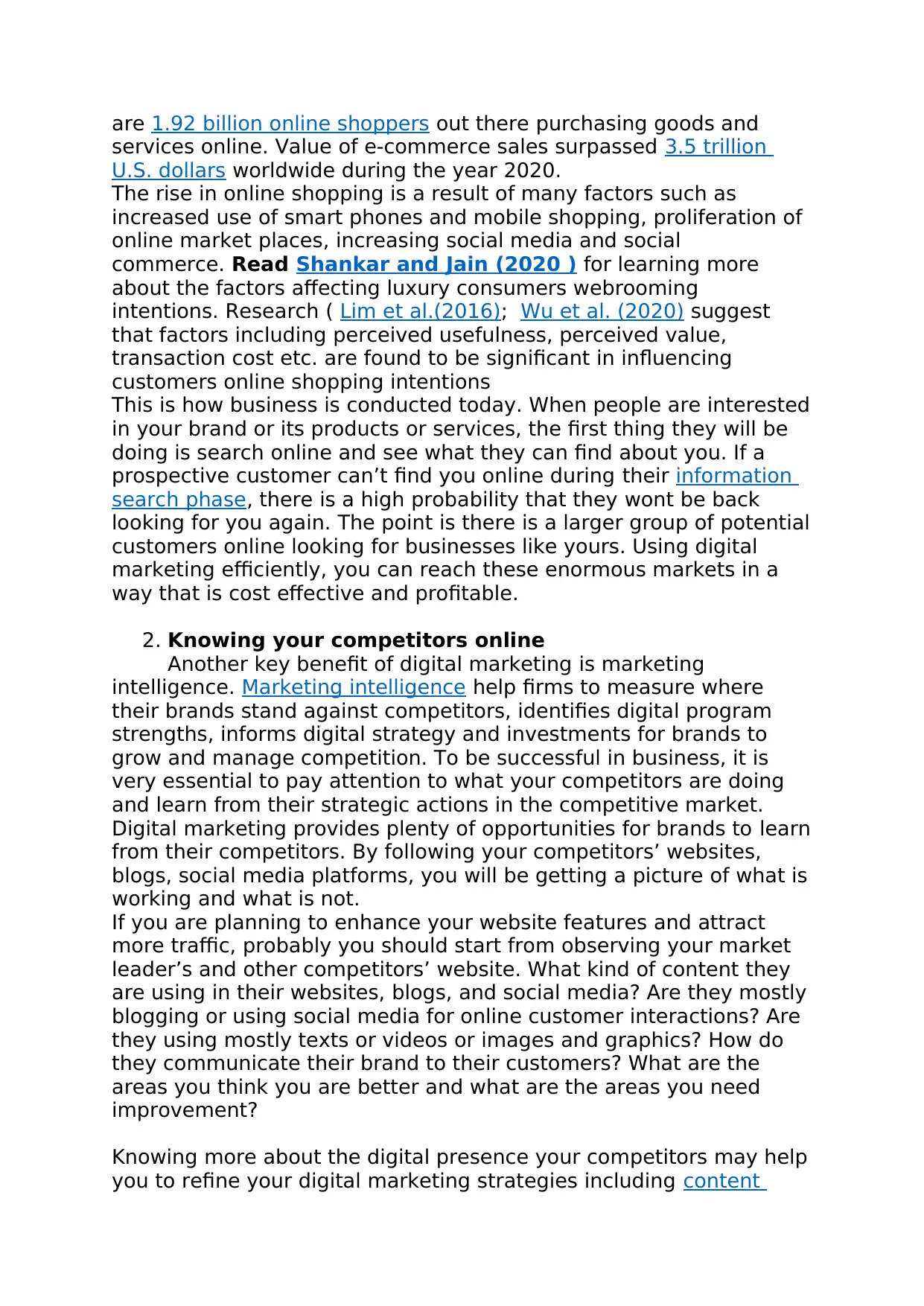
are 1.92 billion online shoppers out there purchasing goods and
services online. Value of e-commerce sales surpassed 3.5 trillion
U.S. dollars worldwide during the year 2020.
The rise in online shopping is a result of many factors such as
increased use of smart phones and mobile shopping, proliferation of
online market places, increasing social media and social
commerce. Read Shankar and Jain (2020 ) for learning more
about the factors affecting luxury consumers webrooming
intentions. Research ( Lim et al.(2016); Wu et al. (2020) suggest
that factors including perceived usefulness, perceived value,
transaction cost etc. are found to be significant in influencing
customers online shopping intentions
This is how business is conducted today. When people are interested
in your brand or its products or services, the first thing they will be
doing is search online and see what they can find about you. If a
prospective customer can’t find you online during their information
search phase, there is a high probability that they wont be back
looking for you again. The point is there is a larger group of potential
customers online looking for businesses like yours. Using digital
marketing efficiently, you can reach these enormous markets in a
way that is cost effective and profitable.
2. Knowing your competitors online
Another key benefit of digital marketing is marketing
intelligence. Marketing intelligence help firms to measure where
their brands stand against competitors, identifies digital program
strengths, informs digital strategy and investments for brands to
grow and manage competition. To be successful in business, it is
very essential to pay attention to what your competitors are doing
and learn from their strategic actions in the competitive market.
Digital marketing provides plenty of opportunities for brands to learn
from their competitors. By following your competitors’ websites,
blogs, social media platforms, you will be getting a picture of what is
working and what is not.
If you are planning to enhance your website features and attract
more traffic, probably you should start from observing your market
leader’s and other competitors’ website. What kind of content they
are using in their websites, blogs, and social media? Are they mostly
blogging or using social media for online customer interactions? Are
they using mostly texts or videos or images and graphics? How do
they communicate their brand to their customers? What are the
areas you think you are better and what are the areas you need
improvement?
Knowing more about the digital presence your competitors may help
you to refine your digital marketing strategies including content
services online. Value of e-commerce sales surpassed 3.5 trillion
U.S. dollars worldwide during the year 2020.
The rise in online shopping is a result of many factors such as
increased use of smart phones and mobile shopping, proliferation of
online market places, increasing social media and social
commerce. Read Shankar and Jain (2020 ) for learning more
about the factors affecting luxury consumers webrooming
intentions. Research ( Lim et al.(2016); Wu et al. (2020) suggest
that factors including perceived usefulness, perceived value,
transaction cost etc. are found to be significant in influencing
customers online shopping intentions
This is how business is conducted today. When people are interested
in your brand or its products or services, the first thing they will be
doing is search online and see what they can find about you. If a
prospective customer can’t find you online during their information
search phase, there is a high probability that they wont be back
looking for you again. The point is there is a larger group of potential
customers online looking for businesses like yours. Using digital
marketing efficiently, you can reach these enormous markets in a
way that is cost effective and profitable.
2. Knowing your competitors online
Another key benefit of digital marketing is marketing
intelligence. Marketing intelligence help firms to measure where
their brands stand against competitors, identifies digital program
strengths, informs digital strategy and investments for brands to
grow and manage competition. To be successful in business, it is
very essential to pay attention to what your competitors are doing
and learn from their strategic actions in the competitive market.
Digital marketing provides plenty of opportunities for brands to learn
from their competitors. By following your competitors’ websites,
blogs, social media platforms, you will be getting a picture of what is
working and what is not.
If you are planning to enhance your website features and attract
more traffic, probably you should start from observing your market
leader’s and other competitors’ website. What kind of content they
are using in their websites, blogs, and social media? Are they mostly
blogging or using social media for online customer interactions? Are
they using mostly texts or videos or images and graphics? How do
they communicate their brand to their customers? What are the
areas you think you are better and what are the areas you need
improvement?
Knowing more about the digital presence your competitors may help
you to refine your digital marketing strategies including content
Paraphrase This Document
Need a fresh take? Get an instant paraphrase of this document with our AI Paraphraser
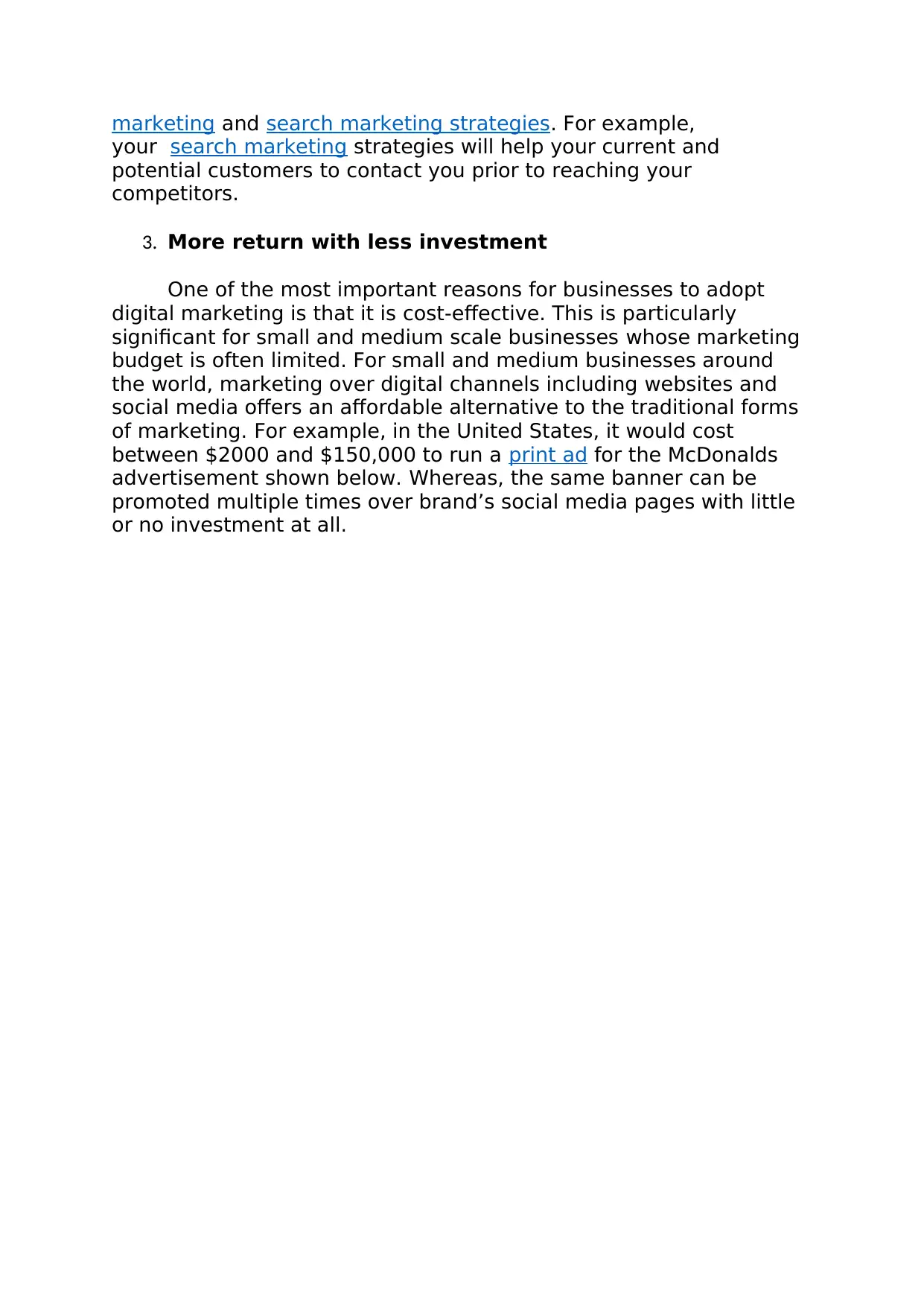
marketing and search marketing strategies. For example,
your search marketing strategies will help your current and
potential customers to contact you prior to reaching your
competitors.
3. More return with less investment
One of the most important reasons for businesses to adopt
digital marketing is that it is cost-effective. This is particularly
significant for small and medium scale businesses whose marketing
budget is often limited. For small and medium businesses around
the world, marketing over digital channels including websites and
social media offers an affordable alternative to the traditional forms
of marketing. For example, in the United States, it would cost
between $2000 and $150,000 to run a print ad for the McDonalds
advertisement shown below. Whereas, the same banner can be
promoted multiple times over brand’s social media pages with little
or no investment at all.
your search marketing strategies will help your current and
potential customers to contact you prior to reaching your
competitors.
3. More return with less investment
One of the most important reasons for businesses to adopt
digital marketing is that it is cost-effective. This is particularly
significant for small and medium scale businesses whose marketing
budget is often limited. For small and medium businesses around
the world, marketing over digital channels including websites and
social media offers an affordable alternative to the traditional forms
of marketing. For example, in the United States, it would cost
between $2000 and $150,000 to run a print ad for the McDonalds
advertisement shown below. Whereas, the same banner can be
promoted multiple times over brand’s social media pages with little
or no investment at all.
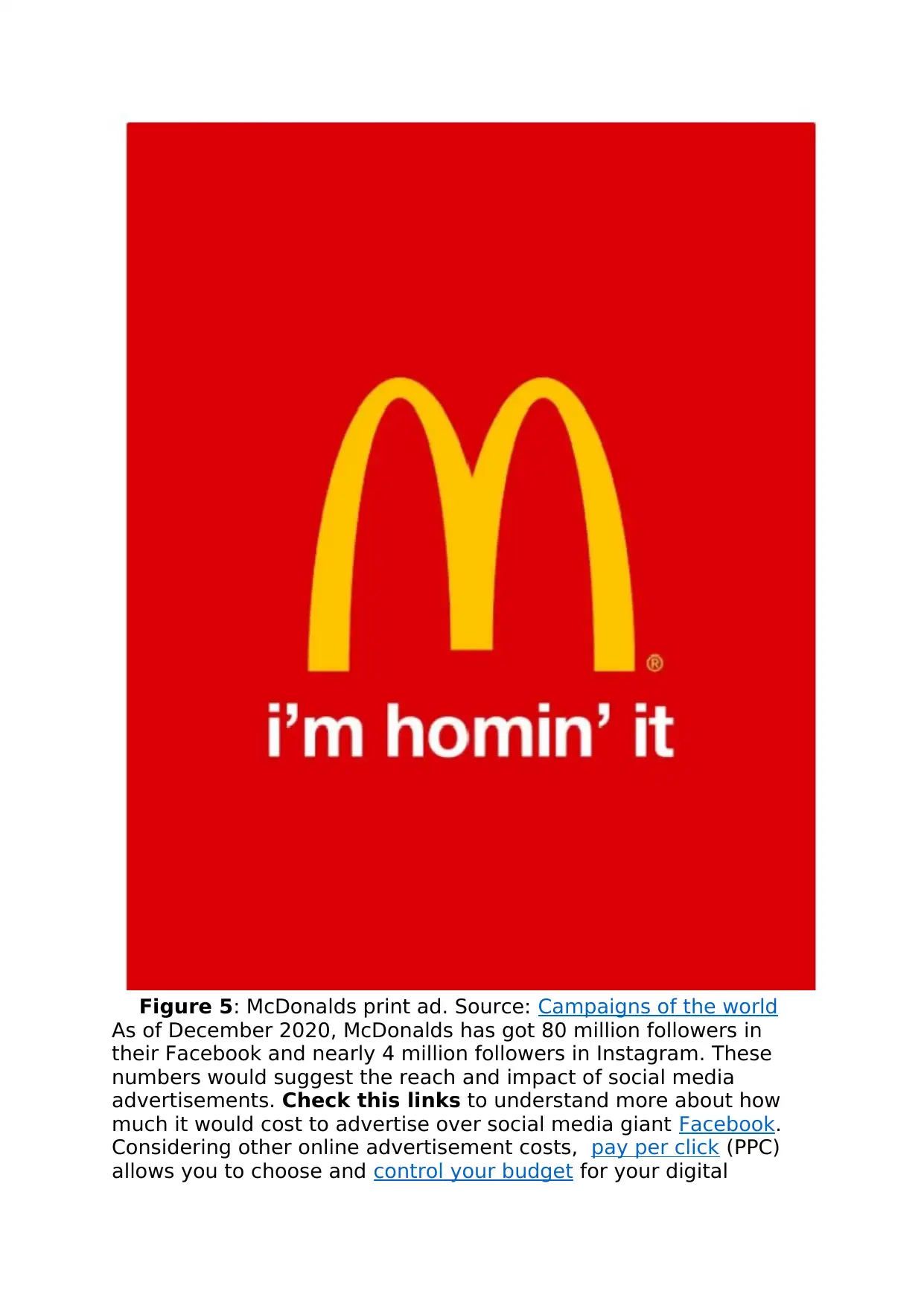
Figure 5: McDonalds print ad. Source: Campaigns of the world
As of December 2020, McDonalds has got 80 million followers in
their Facebook and nearly 4 million followers in Instagram. These
numbers would suggest the reach and impact of social media
advertisements. Check this links to understand more about how
much it would cost to advertise over social media giant Facebook.
Considering other online advertisement costs, pay per click (PPC)
allows you to choose and control your budget for your digital
As of December 2020, McDonalds has got 80 million followers in
their Facebook and nearly 4 million followers in Instagram. These
numbers would suggest the reach and impact of social media
advertisements. Check this links to understand more about how
much it would cost to advertise over social media giant Facebook.
Considering other online advertisement costs, pay per click (PPC)
allows you to choose and control your budget for your digital
⊘ This is a preview!⊘
Do you want full access?
Subscribe today to unlock all pages.

Trusted by 1+ million students worldwide
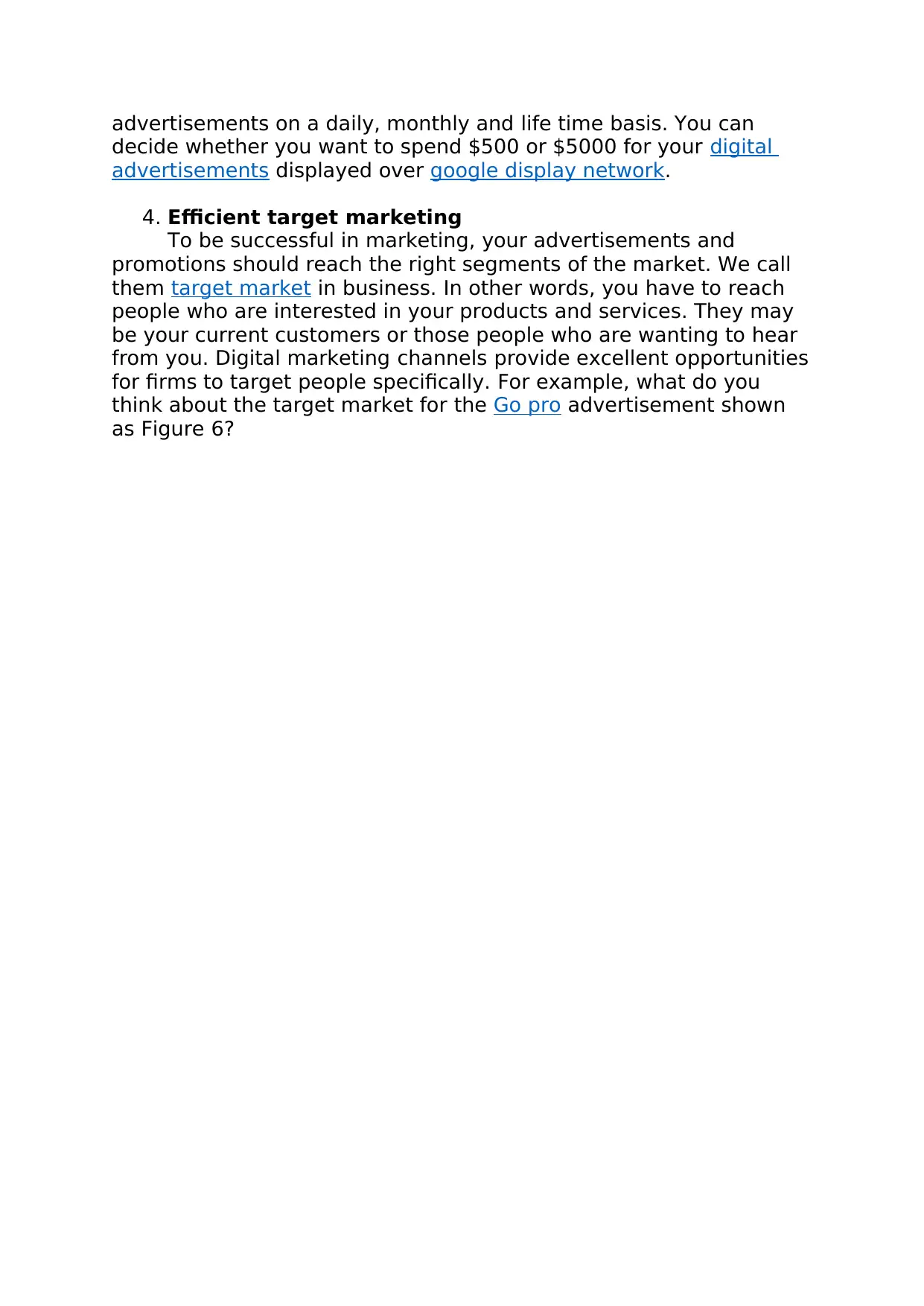
advertisements on a daily, monthly and life time basis. You can
decide whether you want to spend $500 or $5000 for your digital
advertisements displayed over google display network.
4. Efficient target marketing
To be successful in marketing, your advertisements and
promotions should reach the right segments of the market. We call
them target market in business. In other words, you have to reach
people who are interested in your products and services. They may
be your current customers or those people who are wanting to hear
from you. Digital marketing channels provide excellent opportunities
for firms to target people specifically. For example, what do you
think about the target market for the Go pro advertisement shown
as Figure 6?
decide whether you want to spend $500 or $5000 for your digital
advertisements displayed over google display network.
4. Efficient target marketing
To be successful in marketing, your advertisements and
promotions should reach the right segments of the market. We call
them target market in business. In other words, you have to reach
people who are interested in your products and services. They may
be your current customers or those people who are wanting to hear
from you. Digital marketing channels provide excellent opportunities
for firms to target people specifically. For example, what do you
think about the target market for the Go pro advertisement shown
as Figure 6?
Paraphrase This Document
Need a fresh take? Get an instant paraphrase of this document with our AI Paraphraser

Figure 6: GoPro Facebook advertisement. Source: GoPro
Of course, the answer would be individuals who are interested in
travelling, outings, photography etc. We might also target
photographers, tourists, and others who have visited GoPro websites
before, but didn’t complete the purchase yet. Anyone who are
following GoPro social media pages might be another pick as they
have clearly expressed their interest in firms’ products and services.
Today, almost all digital platforms including search engines like
Of course, the answer would be individuals who are interested in
travelling, outings, photography etc. We might also target
photographers, tourists, and others who have visited GoPro websites
before, but didn’t complete the purchase yet. Anyone who are
following GoPro social media pages might be another pick as they
have clearly expressed their interest in firms’ products and services.
Today, almost all digital platforms including search engines like
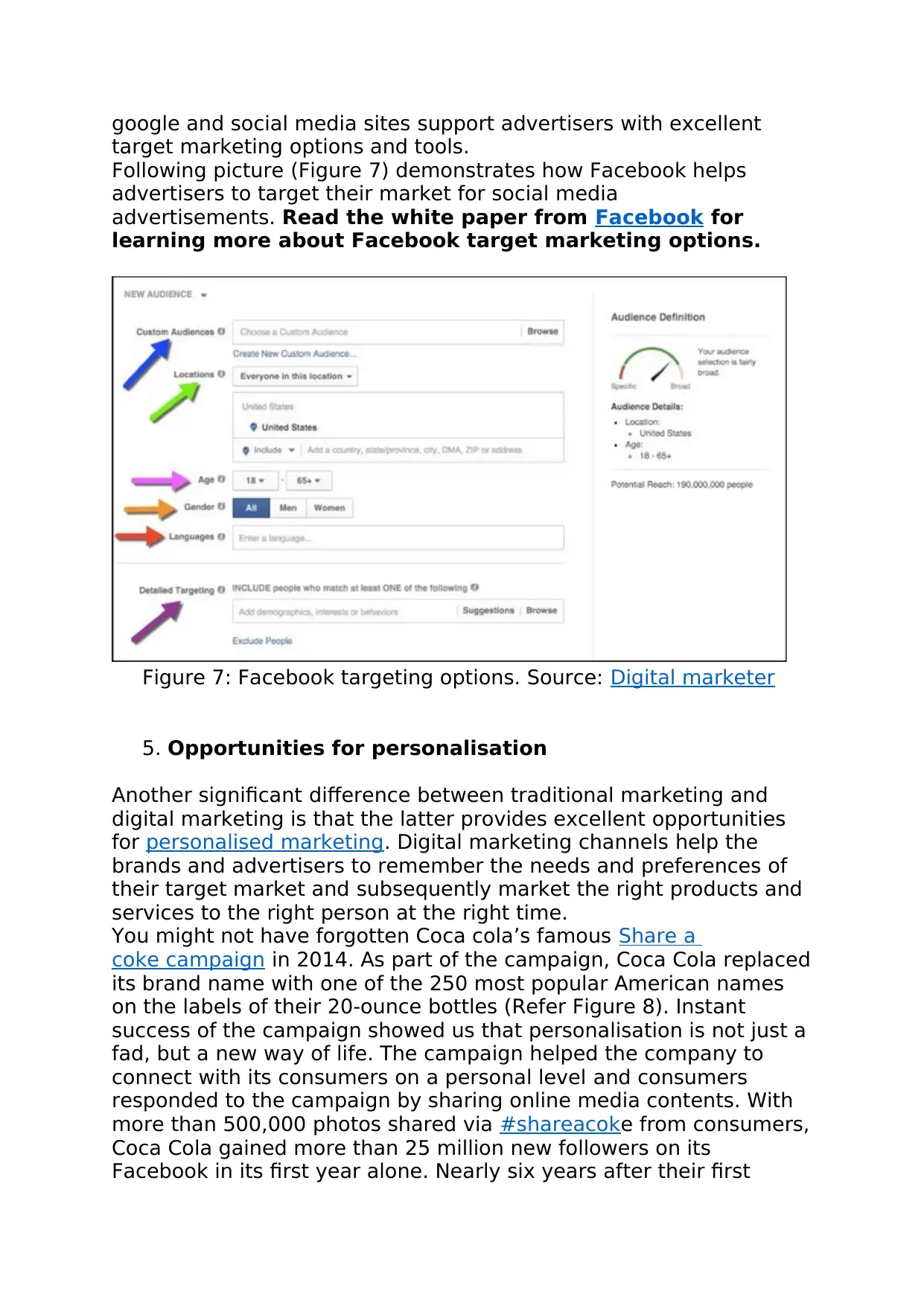
google and social media sites support advertisers with excellent
target marketing options and tools.
Following picture (Figure 7) demonstrates how Facebook helps
advertisers to target their market for social media
advertisements. Read the white paper from Facebook for
learning more about Facebook target marketing options.
Figure 7: Facebook targeting options. Source: Digital marketer
5. Opportunities for personalisation
Another significant difference between traditional marketing and
digital marketing is that the latter provides excellent opportunities
for personalised marketing. Digital marketing channels help the
brands and advertisers to remember the needs and preferences of
their target market and subsequently market the right products and
services to the right person at the right time.
You might not have forgotten Coca cola’s famous Share a
coke campaign in 2014. As part of the campaign, Coca Cola replaced
its brand name with one of the 250 most popular American names
on the labels of their 20-ounce bottles (Refer Figure 8). Instant
success of the campaign showed us that personalisation is not just a
fad, but a new way of life. The campaign helped the company to
connect with its consumers on a personal level and consumers
responded to the campaign by sharing online media contents. With
more than 500,000 photos shared via #shareacoke from consumers,
Coca Cola gained more than 25 million new followers on its
Facebook in its first year alone. Nearly six years after their first
target marketing options and tools.
Following picture (Figure 7) demonstrates how Facebook helps
advertisers to target their market for social media
advertisements. Read the white paper from Facebook for
learning more about Facebook target marketing options.
Figure 7: Facebook targeting options. Source: Digital marketer
5. Opportunities for personalisation
Another significant difference between traditional marketing and
digital marketing is that the latter provides excellent opportunities
for personalised marketing. Digital marketing channels help the
brands and advertisers to remember the needs and preferences of
their target market and subsequently market the right products and
services to the right person at the right time.
You might not have forgotten Coca cola’s famous Share a
coke campaign in 2014. As part of the campaign, Coca Cola replaced
its brand name with one of the 250 most popular American names
on the labels of their 20-ounce bottles (Refer Figure 8). Instant
success of the campaign showed us that personalisation is not just a
fad, but a new way of life. The campaign helped the company to
connect with its consumers on a personal level and consumers
responded to the campaign by sharing online media contents. With
more than 500,000 photos shared via #shareacoke from consumers,
Coca Cola gained more than 25 million new followers on its
Facebook in its first year alone. Nearly six years after their first
⊘ This is a preview!⊘
Do you want full access?
Subscribe today to unlock all pages.

Trusted by 1+ million students worldwide
1 out of 29
Related Documents
Your All-in-One AI-Powered Toolkit for Academic Success.
+13062052269
info@desklib.com
Available 24*7 on WhatsApp / Email
![[object Object]](/_next/static/media/star-bottom.7253800d.svg)
Unlock your academic potential
Copyright © 2020–2025 A2Z Services. All Rights Reserved. Developed and managed by ZUCOL.




